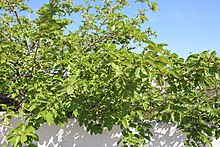
Back Witmoerbei Afrikaans Morus alba AN توت أبيض Arabic توت ابيض ARZ নুনী Assamese Ağ tut Azerbaijani آغ توت AZB Шаўкоўніца белая Byelorussian Бяла черница Bulgarian সাদা তুঁত Bengali/Bangla
| White mulberry | |
|---|---|

| |
| Scientific classification | |
| Kingdom: | Plantae |
| Clade: | Tracheophytes |
| Clade: | Angiosperms |
| Clade: | Eudicots |
| Clade: | Rosids |
| Order: | Rosales |
| Family: | Moraceae |
| Genus: | Morus |
| Species: | M. alba
|
| Binomial name | |
| Morus alba L. 1753
| |
| Subspecies | |
| |
| Synonyms[1] | |
| |
Morus alba, known as white mulberry, common mulberry and silkworm mulberry,[2] is a fast-growing, small to medium-sized mulberry tree which grows to 10–20 m (33–66 ft) tall. It is generally a short-lived tree with a lifespan comparable to that of humans, although there are some specimens known to be more than 250 years old.[3] The species is native to China and India[4] and is widely cultivated and naturalized elsewhere (including United States, Mexico, Australia, Kyrgyzstan, Argentina, Turkey, Iran, and many others).[5][6][7][8][9][10]
The white mulberry is widely cultivated to feed the silkworms employed in the commercial production of silk. It is also notable for the rapid release of its pollen, which is launched at greater than half the speed of sound.[11] Its berries are edible when ripe.
- ^ "Morus alba L.". World Checklist of Selected Plant Families. Royal Botanic Gardens, Kew – via The Plant List. Note that this website has been superseded by World Flora Online
- ^ Morus alba L. by Weeds of Australia - Biosecurity Queensland Edition (Queensland Government)
- ^ "The thickest, tallest, and oldest white mulberry trees (Morus alba)".
- ^ Patel, Raman; Hazra, Taposhi; Rana, Rajendra Singh; Hazra, Manoshi; Bera, Subir; Khan, Mahasin Ali (2021). "First fossil record of mulberry from Asia". Review of Palaeobotany and Palynology. 292: 104459. Bibcode:2021RPaPa.29204459P. doi:10.1016/j.revpalbo.2021.104459. ISSN 0034-6667.
- ^ Cite error: The named reference
FoCMawas invoked but never defined (see the help page). - ^ "Morus alba". Flora of China. 5: 23. Retrieved 26 August 2022.
- ^ Wunderlin, Richard P. (1997). "Morus alba". In Flora of North America Editorial Committee (ed.). Flora of North America North of Mexico (FNA). Vol. 3. New York and Oxford: Oxford University Press – via eFloras.org, Missouri Botanical Garden, St. Louis, MO & Harvard University Herbaria, Cambridge, MA.
- ^ "Morus alba". County-level distribution map from the North American Plant Atlas (NAPA). Biota of North America Program (BONAP). 2014.
- ^ Atlas of Living Australia, Morus alba L., White Mulberry[permanent dead link]
- ^ SEINet, Southwestern Biodiversity, Arizona chapter photos, description, distribution map
- ^ Taylor, Philip; Gwyneth Card; James House; Michael Dickinson; Richard Flagan (2006-03-01). "High-speed pollen release in the white mulberry tree, Morus alba L". Sexual Plant Reproduction. 19 (1): 19–24. doi:10.1007/s00497-005-0018-9. S2CID 39703983.
© MMXXIII Rich X Search. We shall prevail. All rights reserved. Rich X Search